
1,000 SMUHSD students walk out to protest in Central Park
The Aragon Outlook Editors
Article — Video — Photos — Reflection — Profile
A week after Donald Trump won the presidential election, about 1,000 students from Aragon, San Mateo and Hillsdale high schools walked out of school to Central Park in San Mateo in a demonstration to promote values of acceptance and unity, at approximately 1:30 p.m. on Tuesday, Nov. 15.
The rally occurred concurrently with a similar walkout in Palo Alto high schools at 2 p.m., although the protests seem to have been planned separately. The events come after a week full of protests across the country, including a walkout of over 10,000 students on Thursday, Nov. 10 from the San Francisco Union High School District.
Just as students were leaving campus to go to Central Park, a school fire alarm went off, but the two events were unrelated, according to administration.
“It was a faulty fire detector,” says Aragon principal Patricia Kurtz, “The timing seemed strange, but it had nothing to do with [the protest] it was on the second floor all the way up behind a locked door.”
Senior Nicole Jimenez-Mota was the lead organizer of the demonstration. “I just felt that the students needed to feel empowered and heard, [so I thought] let’s have a walkout, let’s have a demonstration, so that students know that they are heard and accepted on campus and in our community,” she explains, “I started posting on social media about it, and eventually students from San Mateo and Hillsdale got in contact with me, and told us they wanted to partner up and do this with us. We met up on Saturday and planned the whole thing out.”
The event was largely publicized through social media, explaining to Aragon students to meet in the grass field by Alameda de las Pulgas at 1:30 p.m. before walking down to Central Park, as well as asking students to wear black to identify themselves with the demonstration.
Jimenez-Mota, as well as Hillsdale junior Micah Dayag and San Mateo senior Nancy Gama, who organized the protest with Jimenez-Mota, contacted school administration to make them aware of the protest.
“They came to let me know what they were going to do, they just shared their plan with me just to let us know what they were doing, which was very respectable of them,” says Kurtz.
While none of the schools actively discouraged students from leaving campus, Superintendent Kevin Skelly made clear that attending the protest was an unexcused absence. Skelly sent out an email to parents the night before the protest.
The email read, “Instructional time will continue for those students who do not participate in the protest. We are asking parents and families to help us by communicating with your student so that you are aware of your student’s intentions for Tuesday.”
Students also informed police of the demonstration. Police officers escorted students as they walked down to Central Park, and about eight police officers were present at the event itself, including each school’s Student Resource Officer.
“We’re just ensuring that [the students] are safe, and more important that [students] got here safe,” says Aragon Student Resource Officer Steve Bennett, “Each school had a couple of officers to follow them — [for Aragon,] crossing El Camino was a big concern, and we also wanted to make sure that no one did anything drastic or illegal, but it’s been a very peaceful [demonstration].”
At the event, Jimenez-Mota made clear to students that the event wasn’t to protest the results of the election.
“This is not about Trump. This is not about hate,” she says, “This is about love, and unity, and acceptance.”
After the election, there have been reports of an increasing number of hate crimes throughout the country. Some attribute this to Trump’s largely negative rhetoric during the election campaign, saying that his win gave a license to his supporters to commit these hate crimes.
According to Jimenez-Mota, the San Mateo high schools’ protest was against this sort of violence and hate speech, rather than Trump’s election itself.
Although some students didn’t participate in this spirit, shouting phrases like “F— Donald Trump,” Jimenez-Mota was quick to stop these students and maintain the positive intent of the walkout.
Students used a stage near the middle of Central Park as the main focus of the demonstration, where students gave speeches, and led chants, such as “love, not hate,” and “united we will not be divided.”
The organizers did have a microphone and a speaker system for the speeches, but it barely reached the perimeter of the crowd, and often couldn’t be heard over noise from the crowd.
Besides speeches, students also had the opportunity to make posters at the event, and could write letters to local and state representatives, including Senators Dianne Feinstein and Kamala Harris and Congresswoman Jackie Speier. About 60 envelopes were prelabeled with the representatives’ addresses for students to write letters to.
“The [letter writing station] is there so their voices are being heard even if they don’t want to come onto the stage and speak,” Jimenez-Mota says, “and the [poster station] is just to empower them through different ways of expression besides talking.”
Junior Olivia Tobin was one student who made use of the letter writing station. “I wrote a letter to Kamala Harris because after the election, I was feeling really down, and I saw this one post on Instagram [with a] a picture of her,” Tobin says, “I saw that she was the second black female Senator. I thought that was really cool. It gave me a glimmer of hope in a time that I felt really disappointed and sad about the election results.”
Supporters at the event weren’t limited to students — San Mateo Union High School District Board Trustee Marc Friedman was also at the event.
“I sympathize with what the students are doing, individually, not as part of the school district. I support what they’re saying. I give them a lot of credit for doing it,” Friedman explains.
The event’s 1,000 supporters drew considerable media coverage. Along with the San Mateo Daily Journal, reporters from KRON 4, ABC 7 News and Univision 14 all covered the event.
Besides students from Aragon, Hillsdale and San Mateo, a few students from other schools, such as Design Tech high school in Burlingame, and Middle College students from the College of San Mateo attended the protest as well.
“I wasn’t expecting this many people,” said San Mateo High senior Nancy Gama, one of the student organizers, “It makes me want to cry because it’s just beautiful how many people actually showed up.”
While turnout for the event was high, it’s unclear how many students were actually protesting, and how many were using the demonstration as an excuse to skip out on class.
However, Jimenez-Mota sees the bandwagoners with a positive outlook. “Everyone’s getting marked absent at school that’s here, so they can bandwagon all they want, but at the end of the day, they are still hearing the messages we are sending here on the stage,” she says, “so hopefully they will gain some knowledge or encouragement from this because they are here. Maybe their whole purpose wasn’t to be a part of this, but with being here and hearing these messages it will be.”
On the other hand, some question the effectiveness of the protest.
“I feel like leaving the school would be a disrespect to the teachers,” says senior Alexandra Varallo, “and I feel that stepping out of school wouldn’t really have much of an effect.”
Government and Economics teacher Kevin Nelson suggests that participating in a protest isn’t enough. “I think that this is a positive outlet for students to voice their opinions, but I would hope that they would go farther. It’s not just walking out at Central Park and having speeches,” he says, “It’s raising money, joining a [political] party, getting politically active — not just having a day or two days of being upset, but really realistically understanding change.”
One student, senior Stephanie Shu, posted on Facebook explaining her reasons for not attending the protest.
“There’s definitely a sense that it’s still in some way protesting Trump … [so] it could alienate students who are Trump supporters. Regardless of whether or not that is [their] intention,” the post read, “Imagine if the tables were turned, and Clinton won. Any protest remotely related to the election would be ridiculed by the majority of our student body. We’d call them bigots. And minority students would feel uncomfortable around people who might attend a rally like that. It’s especially important that we keep our school safe for everyone, even people we disagree with. Anyway, despite our differences I think [the] cause is nevertheless admirable. Thank you for being caring and wanting to create a safe space.”
The protest did affect 6th and 7th period classes at Aragon — for example, over three quarters of Mr. Nelson’s 7th period students didn’t come to class.
Says science teacher Cathryn Kliegel, “I think it’s important for students to be in class. I think political activity is important, but it can be done outside of school. [The demonstration] has laudable goals, but I think they’re doing it at the wrong time. I do not like my students missing my classes.”
Again, students who attended the protest are marked with unexcused absences for 6th and 7th period. According to Dean Michael Valmonte, the consequence for one unexcused absence (per period) is two detentions, and the consequence for two unexcused absences is four detentions or Saturday School.
A few social media posts advertising the protest claimed that the event was ‘cleared’ by the administration, implying that there would be no consequences for attending the protest. These claims were misleading — the administration was made aware of a protest, and didn’t actively discourage students from participating, but the consequence for cutting class still applied.
However, the student organizers believed that having the event during school hours was important.
“By doing it during school, we’re making a statement. If we did it after school, it would show that we are still scared. We want to stand strong and make a statement that we are coming here together in unity,” says Hillsdale junior Micah Dayag, one of the student organizers, “Hillsdale and Aragon, we may be rivals when it comes to sports, but when it comes to reality and what’s happening in the world, we are humans first and we unite together.”
Written by Karan Nevatia, with additional reporting by Ashley Tsang, Avichal Goel, Esther Lin, Franchesca Carracedo, Isabel Chao, Richard Yu and Victoria Fong.
Article — Video — Photos — Reflection — Profile
Article — Video — Photos — Reflection — Profile
Looking back at the protest in Central Park: a reflection by Anders Zhou
On the Thursday following the election of Donald Trump, I remember receiving a message from Nicole Jimenez. I remembered Nicole as a friend whom I sat next to in history class last year.
To be honest, I was surprised that I still had her name saved. I hadn’t talked to her for some while, so I wasn’t sure what to expect.
It seemed as though Nicole wanted to let me in on a walkout protesting Donald Trump. Still angry over the results of the election, I wholeheartedly supported the idea of taking class time outside of school to vent my frustration.
Nicole also invited Aragon’s Black Student Union and Latino Club, indicating that this rally would also be a focused, intersectional effort.
I spent the following weekend in a limbo. I had schoolwork to finish, and I was worried about what would happen with the protest. I wasn’t sure of the date, and it seemed to me as if a lot of other students were also wondering what the focus of this protest was — many voiced their disagreement on Facebook over the protest if indeed it held an anti-Trump sentiment.
After some tension, the protest was finally set on Tuesday. I immediately set my heart on going. I was proud to be a part of GSA and represent the LGBTQ+ community at the protest, and I couldn’t wait to be a part of the movement.
The day of the protest, we walked down Aragon boulevard. The whole experience was surreal; police motorcycles passed by us, but none of the protesters seemed to care. A couple homeowners stepped out to take pictures of us. A few passing drivers rolled down their windows, voiced their opposition to our movement, and asked us to return to school peacefully. But I knew that what we were doing was already peaceful. In fact, Nicole had urged us, when we gathered on the Alameda, to understand that our protest was not going to be a anti-Trump — rather, it was going to be a protest about love and acceptance and solidarity. I believe most of us took this to heart, because a majority of the signs and decorations that the protesters brought out urged onlookers to respect the rights of colored, LGBTQ+, and female citizens.
It was relatively empty in Central Park. We were the first ones there, and about 300 of us lined up against the stage next to the Japanese garden. A banner reading “United we will not be divided” unfurled before the crowd, and Nicole began to speak.
As students from San Mateo and Hillsdale High began to trickle in, the atmosphere intensified. There were posters, face paint, and pride flags displayed throughout the crowd, and many students came up to the stage to speak.
My own opportunity to speak came up when Justin invited me to express my thoughts on behalf of Aragon’s Gender and Sexuality Awareness club.
I invited everyone to recognize the exigency of intersectionality between minority groups. The current political situation was evident to me; our president-elect didn’t attack one group — he attacked all groups. And so I wanted everyone to understand how important it was to uplift each others.
When one group falls, everyone falls.
That’s the message I hoped would carry through the crowd. Even as the students from San Mateo and Hillsdale high trickled in, countless speeches reiterated how important it was to fight as a community, and not as an organization. I remember being brought to tears after seeing two flags — a Mexican flag and a Gender and Sexuality Awareness flag — tied together as one larger flag.
So here’s my reflection: there will be those who ask us to go home. Perhaps, we should not have sacrificed the hard work of our teachers for our own motivations. Perhaps our protest was a selfish movement. For the most part, we live in the Bay Area, where we are already sheltered by a rather progressive sphere of cultural and political elitism and wealth.
However, even in the political climate of the Bay Area, our emotional safety is not guaranteed.
It’s really not up to the Latino population, to the transgender community, or to women to fight the battle against oppression. When one group loses their right to their body, we all suffer. When one group gains the right to marriage and liberty, all minority groups benefit from that step forward.
I understand that this is a controversial statement, as it implies that we should allow certain groups to appropriate the pains, difficulties, and successes of others. However, I believe there is something much more to be said when we fight as a group, and not as a consortium of loosely connected minority groups. Pain is not appropriated; pain is suffered. Difficulties are not met individually; they are met communally. Success is not felt by one; it is felt by all. Humanity will not succeed when one gender, racial, ethnic, or socioeconomic group succeeds. There is a fine line to walk when we discuss intersectionality, but I have no doubt that the protest on Tuesday addressed this fine line in a deeper context.
I saw it firsthand with the flag, with the sign that said “I SUPPORT MY UNCLE AND HIS HUSBAND” and with the students from D-tech who took on three hours of detention to fight for their rights. I felt it with the resounding rhetoric of hope throughout the protest.
I know this protest had a profound meaning. I felt it in my heart, as I stood in front of a crowd of 1000.
In my mind, this protest acted as an invitation for further discussion. It opened up possibilities for exploring the possibilities of promoting intersectionality, even on campus.
There’s a whole world of hate coming our way, and there’s no time to relax. Before we tackle the system, we got to build our own system up. It’s game time, guys, and we better be ready to fight.
Article — Video — Photos — Reflection — Profile

“It was like our life got flipped upside-down because he was the main breadwinner in the family. We went from living in a good home to being homeless for awhile because our main source of income was gone and my mother couldn’t sustain 6 children on her own,” remembers senior Nicole Jimenez-Mota about her dad’s deportation in 2008. Since Donald Trump was elected president on Nov. 8, Jimenez-Mota wanted to voice her opinion. Trump’s controversial views on immigration resonated with Jimenez-Mota, compelling her to take action in the San Mateo community.
On Tuesday, Nov. 15, students from San Mateo, Hillsdale and Aragon walked out of class to participate in a demonstration for unity and love. Jimenez-Mota was the lead organizer of the demonstration and felt a personal connection to the election results not only from her dad’s deportation, but also from being a Latina woman.
With Donald Trump being elected president, Jimenez-Mota used the opportunity to unite the community, rather than spread hate. “Listening to Trump’s statements towards women and towards Latinas and towards Mexicans, my ethnicity, that’s what really struck me,” says Jimenez-Mota. During Trump’s presidential campaign, he made several sexist and racist remarks towards women and Latinos. For instance, Trump questioned Hillary Clinton’s stamina, looks and strength in the first presidential debate, all referencing her being a woman. Additionally, Trump’s political goals include building a wall between the United States and Mexico and he has called Mexicans, along with other illegal immigrants, “killers and rapists.”
After the election results, Jimenez-Mota reflected on what she could do to improve others’ attitudes towards the election. “I just remember feeling so down and thinking [about] all the other people. I knew being sad and depressed about it wasn’t going to do anything,” explains Jimenez-Mota. “You can’t change the results of who got elected, but you can do something to make people feel better about the results and feel more hopeful about what’s to come. That’s why I decided to do it: to give people a silver lining to this whole election that was going on.”
Jimenez-Mota is not new to participating in protests, although this was her first time organizing one. “I’ve been a part of many many marches because of my mom and sister. They got heavily involved in immigration rights when my dad was deported,” says Jimenez-Mota.
Seeing her mom and sister as role models, Jimenez-Mota looks up to them for their strength and determination to get their voices heard. Jimenez-Mota’s older sister even organized her own demonstration during her time here at Aragon. “It was for the DREAM [Development, Relief, and Education for Alien Minors] Act. It was endangered of being repealed,” Jimenez-Mota explains, “and they had a day of silence and it was very big, but it was just Aragon. She’s been a huge inspiration for me and all this stuff that I’ve done.” The DREAM Act helps young undocumented immigrants pursue education, paralleling the family’s support for immigration rights.
Additionally, Jimenez-Mota admires her mother’s commitment to letting youth get their voices heard and spoke at the demonstration to show her support. Explaining her mom’s dedication to the cause, Jimenez-Mota says, “She loves making sure that her children feel heard. I think this was an opportunity for her to take all these kids under her wing and make sure that they felt heard. I think it was important to have an adult telling the kids that ‘You’re important. You matter.’”
While Jimenez-Mota is inspired by her mother and sister, her entire family is supportive and encouraging of her. “Almost my whole entire family was there, except for a few of my siblings who couldn’t make it,” says Jimenez-Mota.
A lot of Jimenez-Mota’s determination and strength comes from her dad’s deportation. Jimenez-Mota recalls, “I was 10 when it happened, but it was definitely more like I had to not be a little kid anymore and not worry about little kid things, like making sure that I did everything that I could to take care of myself, so that my mom could worry about everything else. Being a child wasn’t really an option anymore and I was just very independent at the time because my mom didn’t have the time or resources to. It was really hard, but it made me grow up a lot faster and appreciate what I had.”
Co-organizer of the protest and fellow leadership classmate, senior Justin Sell, sees Jimenez-Mota’s drive and passion, not only politics, but also in the classroom. Sell says, “[One of her best attributes is] how passionate she is and how much she clearly felt she needed to do to have a positive impact on her community.”
Although Jimenez-Mota didn’t expect 1,000 people to come to the demonstration, she was blown away the turnout. “Even if only 100 people had showed up, it would’ve been rewarding. It was so amazing to see the huge amount of students unite under one purpose and one cause. It was so beautiful and reassuring to me to know that all these people feel the same way and are there to spread love, positivity and peace,” notes Jimenez-Mota.
While the demonstration was only for one day and had a week’s worth of planning, Jimenez-Mota looks towards the future and wants to continue spreading her message. The day after the protest, Jimenez-Mota contacted a city council member. “He encouraged us not to have this ‘one-hit wonder,’ but really keep the momentum and power of this demonstration going to empower the students further,” Jimenez-Mota adds. “We really are trying and hoping to plan something in January for when Trump gets inaugurated. Hopefully, something bigger and greater will happen because I think that if we can pull 1.000 students off in one week, what [could we] do in a couple of months?”
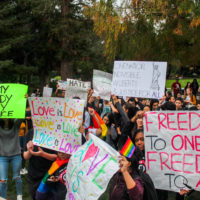

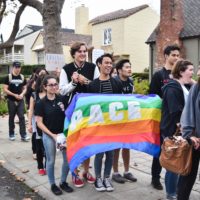
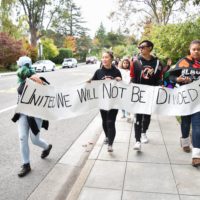

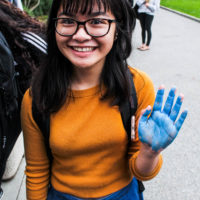
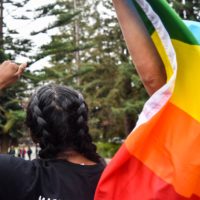
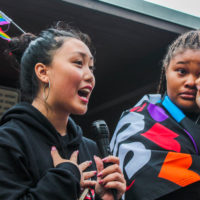
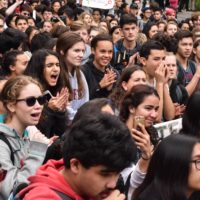
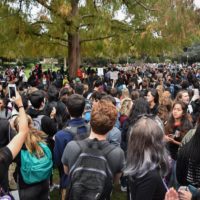
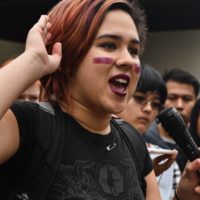






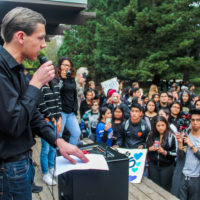
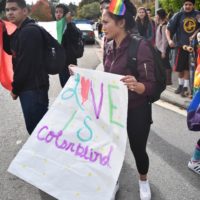

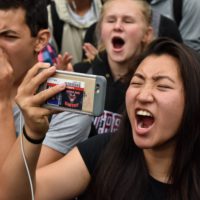

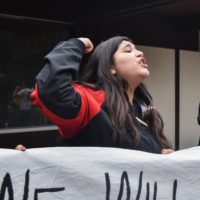

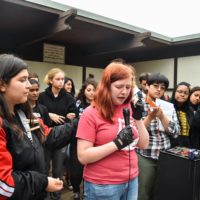
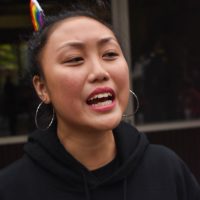
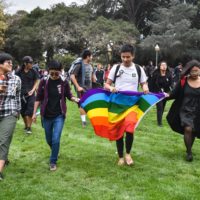
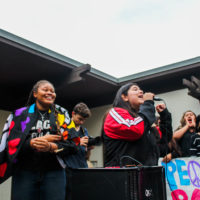
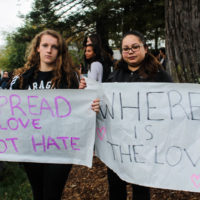
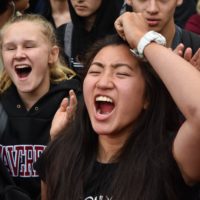

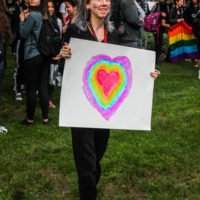
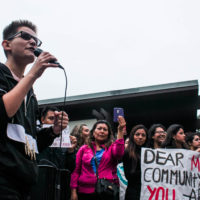

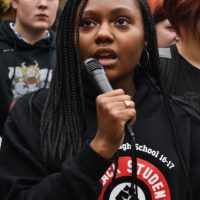
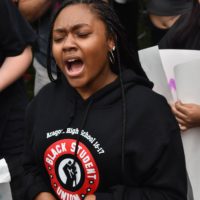
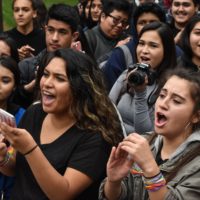
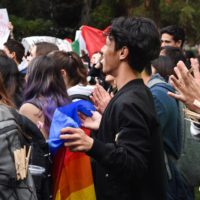
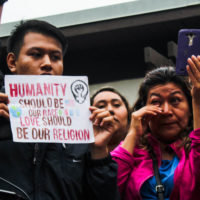

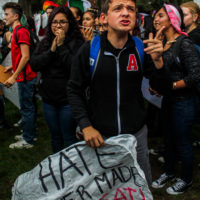


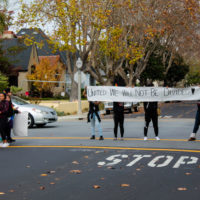
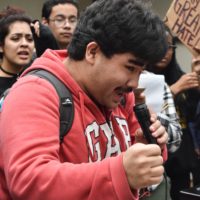
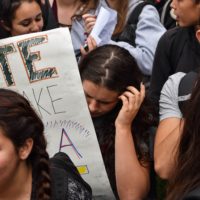
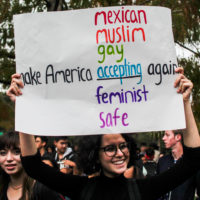




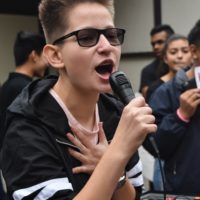


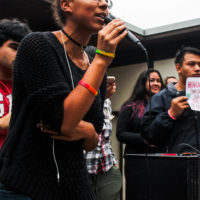
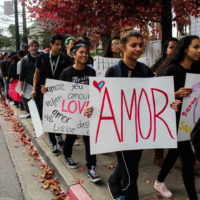
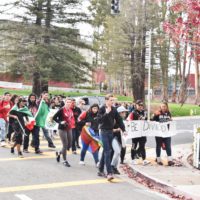

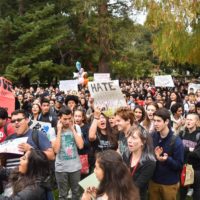

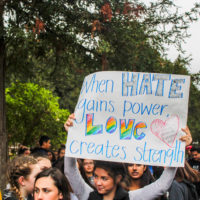
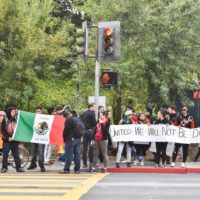


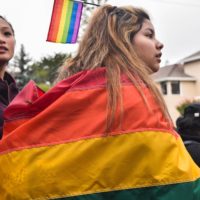
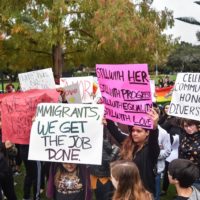
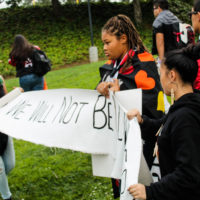
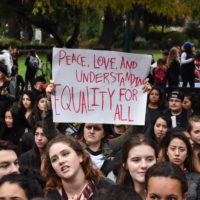


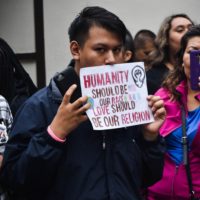
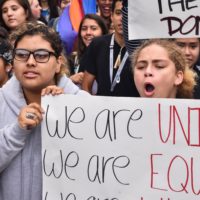
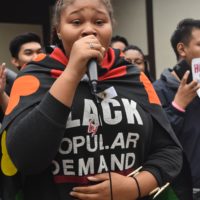
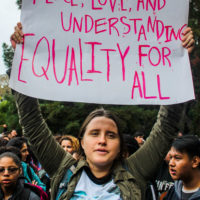
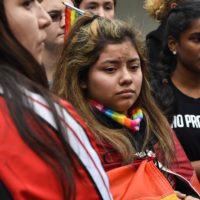

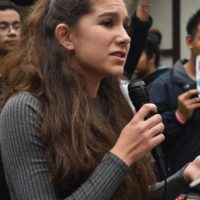
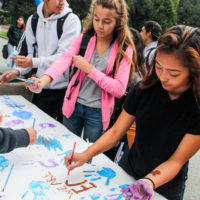

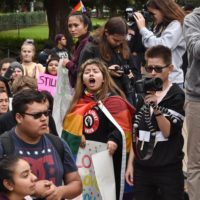
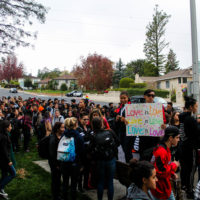

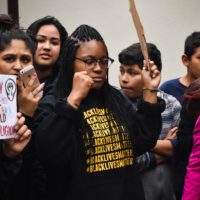
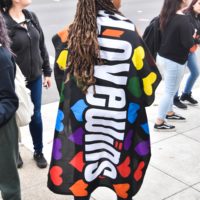

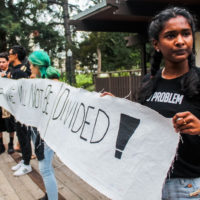
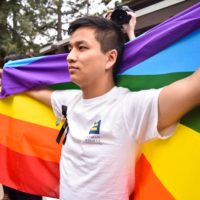
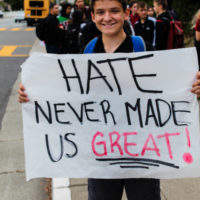
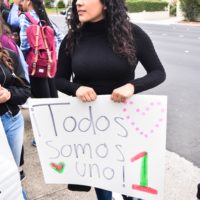

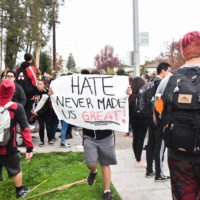
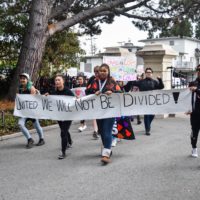
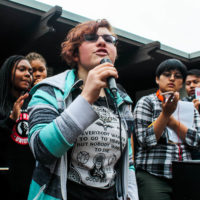

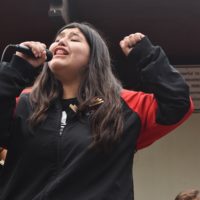

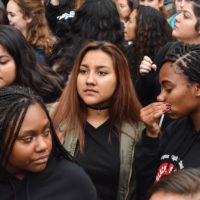


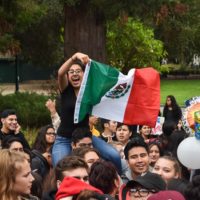
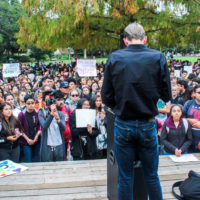
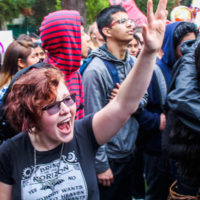


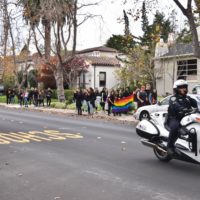

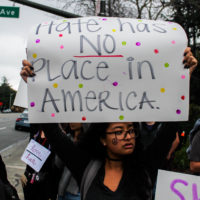
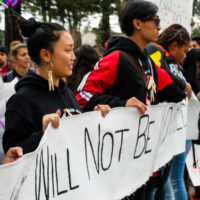


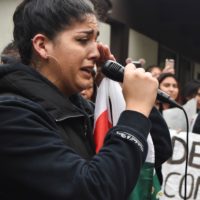
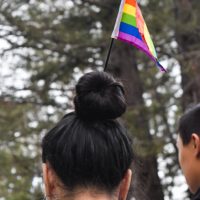




The protest was not peaceful, students Tried to fight Senior Ben Sasounian and also threw starbucks at him for supporting Trump. It was an anti trump protest according to alot of little shits that went.
While violence towards other students is never justified, the student mentioned above has previously made radical/offensive statements such as “Hillary for jail!” and “Black lives don’t matter!”
You know, I asked tech to allow live comments on this thread to invite more community participation and I hope we can all practice mutual respect like we should in any school setting. Hiding behind anonymity and issuing an ad hominem slur (“little ____”) doesn’t impress and doesn’t do much to convince skeptics of the inherent decency of the majority of Trump supporters. The Outlook, the Daily Journal, and 3 TV stations covered the event without taking notice of fighting so I think we should all this comment as hearsay until further notice. If Ben would like to go on the record and be included in the coverage then he should write aragonoutlook@gmail.com. The Outlook is committed to creating news coverage that is truthful and as objective and comprehensive as possible.
Thank you.
Scott Silton
Faculty Adviser
This article does not reflect the rally at all, and I’m shocked it came from your award-winning newspaper staff. With all the quotes from people against the rally, you made this seem like a negative event that most students and teachers did not like at all. So many posters and chants encouraged peace and love, and none of those were really written about. There were speeches from Eliana Grant, Anders Zhao and Justin and Sell that brought people to tears and made people scream at the top of their lungs in encouragement, but you wrote about a Facebook post instead. Again. there were tons of signs that encouraged peace instead of hate, women power, gay pride, and nationality pride, but you wrote about a kid yelling FDT. On Aragon Boulevard, there was a man yelling at Aragon students to return to class because we didn’t know enough to protest because we’re just kids. We walked past him with our heads held high, not a single negative comment made back. But you wrote about our safety crossing El Camino instead. You wrote about kids coming because they wanted to ditch class, which the leader of the protest, Nicole Jimenz-Mota, found to be a good thing in the end. But you made it seem like everyone who left deserves a four hour detention because of your quote from Velmonte. There was an open mic on the stage where people of all races, sexualities, and schools spoke, often crying when they saw the love the crowd was giving them. But you wrote about how the mic barely worked and didn’t reach the whole 1,000 student group. You had a positive quote from Mr. Nelson who seemed to be encouraging to his students to spread their opinions and learn about politics But you also had a quote from a science teacher who did not agree with the walkout at all, and just complained about kids missing their classes. Olivia Tobin’s heartfelt quote was better than hers, and showed how kids can get involved and interested in politics. You wrote about how Nicole J-M used social media to spread the word but later you wrote about how everyone was putting wrong information about the administration’s “clearance” on their posts which made any one who posted about it look like an uninformed liar. Maybe you weren’t supposed to put your own opinion into this article, but mashing a ton of quotes from the two POVs didn’t show the incredible event that happened. But maybe your article is negative because your instructor sent an email to all his students saying they weren’t educated enough to walk out, and should watch a movie in class instead of using their constitution given right of freedom of speech. The Aragon Outlook has written great moving articles, but you did not give this event and it’s speakers justice for all the work they did, and you did not give any students who walked out respect for speaking their mind.
I agree with this comment, my friend said that she felt so empowered she was crying with the stranger next to her and they were both hugging because of the ambiance of the walkout. If this article was meant to show how the younger generations can be,what an adult what call “radical”, than this would make sense.
This right here. This comment by an anonymous student is a more accurate and truthful representation of what the rally was about than this article from a newspaper staff I usually greatly respect for their substantive writing. I would encourage everyone to read the Daily Journal’s article on the protest, which does not attempt to cast a negative light on those who simply care about spreading love in a time of hate. Also, Tessa Ulrich’s video on the rally is also much, much more accurate and consists of better reporting than this article. I hope that the Aragon Outlook will get back to its normal standards of quality.
Great article, Karan! Hearing about this event from my student, I was glad that as a parent I was able to be present for this event.
I grew up in San Mateo and, in fact, attended Aragon high school. At Tuesday’s walk out there were plenty of teens there as an excuse to cut class. I gently reminded a couple of students that their words were being divisive and that it was not helpful towards this cause (encouraging divisiveness between an african american student and the police, calling out “F” Trump and “F” the police!).
Despite some of that (to be expected), I just wanted to express how truly impressed and proud I am of those young minds who had the maturity to not make the focus one about Trump but instead about love, unity and acceptance. Although, plenty of teens were vehemently open about their unhappiness with the election results, enough were there to display true leadership. I was on stage taking pictures and not only saw but felt the emotion from those who got up to speak. Whether it gave just a few students in a body of 1,000 the courage to express themselves, be proud and embrace the newfound support of their peers, I am all for it!
Parent
I think Karan and the whole outlook put together a great article that properly portrays the spectrum of aspects about this event, without adding personal opinion. Excellent journalism.
Well done, Karan and the Outlook staff. A tough endeavor considering the multitude of angles to cover.
Side note: perhaps this would’ve been a good opportunity for video, which many of you know I’ve always encouraged!
-BY ’14
There is a video! Check it out here: https://youtu.be/nWvpHU2q7iM
For what it’s worth, I think that this kind of protest necessarily has to be inclusive of negativity towards Trump. Yes, protest should be an opportunity to make the world a better place and we lead by example, et cetera, et cetera, et cetera, but the fact of the matter is that Trump’s victory and the resultant pall that event has cast over the nation is the reason why the protest happened in the first place. I wasn’t present at the protest, but suppose I had given a speech at the protest that targeted Trump but contained no invective – would I have been asked to step down by an adult or an organizer? Stephanie Shu made quite an egalitarian quote in the article about how we need to be mindful of not alienating Trump supporters, and in theory she is correct, but I think it should also be considered that this a man who has received news coverage of racially charged conflict at his rallies on multiple occasions and was endorsed by the KKK for the presidency, to name but two of the controversies surrounding him. Much of what he says and does would never be allowed on school grounds, and while major news coverage of his supporters is obviously not representative of all his supporters, I think it’s very difficult to defend the bounds of free speech when it comes to Trump’s rhetoric. To actively prevent negative commentary about Trump seems censorious and invites questions of restrictions on the 1st amendment rights of minors outside of school – after all, the protesters were marked absent just like any other student who skips school for more arbitrary reasons, it’s not like SMUHSD can claim domain over the protest and thus set rules of attendance. I’m not trying to condone speech like “F— Trump” (that would make protesters little better than the Trump supporters shown on TV), I just want to raise the issue that students should have a right to publicly express their political beliefs and I believe that includes dissatisfaction or even disgust towards specific politicians.
From the words of Moses Michele Haze “All men are created to be equal” I think this protest was a good example of the meaning of Love not Hate. Even though I want at the protest That didn’t stop me from supporting it.